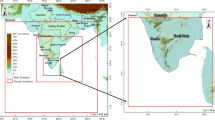Abstract
Formulating model uncertainties for a convection-allowing ensemble prediction system (CAEPS) is a much more challenging problem compared to well-utilized approaches in synoptic weather forecasting. A new approach is proposed and tested through assuming that the model uncertainty should reasonably describe the fast nonlinear error growth of the convection-allowing model, due to the fast developing character and strong nonlinearity of convective events. The Conditional Nonlinear Optimal Perturbation related to Parameters (CNOP-P) is applied in this study. Also, an ensemble approach is adopted to solve the CNOP-P problem. By using five locally developed strong convective events that occurred in pre-rainy season of South China, the most sensitive parameters were detected based on CNOP-P, which resulted in the maximum variations in precipitation. A formulation of model uncertainty is designed by adding stochastic perturbations into these sensitive parameters. Through comparison ensemble experiments by using all the 13 heavy rainfall cases that occurred in the flood season of South China in 2017, the advantages of the CNOP-P-based method are examined and verified by comparing with the well-utilized stochastically perturbed physics tendencies (SPPT) scheme. The results indicate that the CNOP-P-based method has potential in improving the under-dispersive problem of the current CAEPS.
摘要
相对于全球集合预报, 对流尺度集合预报 (CAEPS) 中有关模式不确定性的研究缺乏系统性和理论基础, 成为目前研究的热点和难点. 针对强对流天气发展迅速、 非线性强等特点, 本文充分考虑了对流尺度模式误差非线性快速增长特征, 提出基于条件非线性最优参数扰动 (CNOP-P) 方法研究CAEPS模式不确定性问题的新思路. 同时, 在CNOP-P方法的计算中, 本文采用了集合求解算法, 不依赖于切线伴随模式. 我们首先选取了2017年中国华南前汛期5个典型暖区暴雨个例求解CNOP-P, 得到对累积降水预报产生最大影响的参数扰动集合, 挑选敏感物理参数; 然后, 通过随机扰动敏感参数来描述模式不确定性, 构造基于CNOP-P的模式扰动方案, 并将该方案与目前广泛应用的随机物理参数化倾向扰动方案进行对比, 展开对流尺度集合预报关于模式不确定性的敏感性试验. 2017年华南地区13个强对流过程的检验结果显示: 基于CNOP-P的模式扰动方案对于提高对流尺度集合离散度方面具有应用潜力.
Similar content being viewed by others
References
Baker, L. H., A. C. Rudd, S. Migliorini, and R. N. Bannister, 2014: Representation of model error in a convective-scale ensemble prediction system. Nonlinear Processes in Geophysics, 21, 19–39, https://doi.org/10.5194/npg-21-19-2014.
Baldauf, M., A. Seifert, J. Förstner, D. Majewski, M. Raschendorfer, and T. Reinhardt, 2011: Operational convective-scale numerical weather prediction with the COSMO model: Description and sensitivities. Mon. Wea. Rev., 139, 3887–3905, https://doi.org/10.1175/MWR-D-10-05013.1.
Berner, J., G. J. Shutts, M. Leutbecher, and T. N. Palmer, 2009: A spectral stochastic kinetic energy backscatter scheme and its impact on flow-dependent predictability in the ECMWF ensemble prediction system. J. Atmos. Sci., 66, 603–626, https://doi.org/10.1175/2008JAS2677.1.
Birgin, E. G., J. M. Martínez, and M. Raydan, 2001: Algorithm 813: SPG-software for convex-constrained optimization. ACM Transactions on Mathematical Software, 27, 340–349, https://doi.org/10.1145/502800.502803.
Bouttier, F., B. Vié, O. Nuissier, and L. Raynaud, 2012: Impact of stochastic physics in a convection-permitting ensemble. Mon. Wea. Rev., 140, 3706–3721, https://doi.org/10.1175/MWR-D-12-00031.1.
Bowler, N. E., A. Arribas, K. R. Mylne, K. B. Robertson, and S. E. Beare, 2008: The MOGREPS short-range ensemble prediction system. Quart. J. Roy. Meteorol. Soc., 134, 703–722, https://doi.org/10.1002/qj.234.
Buizza, R., M. Milleer, and T. N. Palmer, 1999: Stochastic representation of model uncertainties in the ECMWF ensemble prediction system. Quart. J. Roy. Meteorol. Soc., 125, 2887–2908, https://doi.org/10.1002/qj.49712556006.
Charron, M., G. Pellerin, L. Spacek, P. L. Houtekamer, N. Gagnon, H. L. Mitchell, and L. Michelin, 2010: Toward random sampling of model error in the Canadian ensemble prediction system. Mon. Wea. Rev., 138, 1877–1901, https://doi.org/10.1175/2009MWR3187.1.
Chen, F., and J. Dudhia, 2001: Coupling an advanced land surfacehydrology model with the Penn State-NCAR MM5 modeling system. Part I: Model implementation and sensitivity. Mon. Wea. Rev., 129, 569–585, https://doi.org/10.1175/1520-0493(2001)129<0569:CAALSH>2.0.CO;2.
Christensen, H. M., S.-J. Lock, I. M. Moroz, and T. N. Palmer, 2017: Introducing independent patterns into the Stochastically Perturbed Parametrization Tendencies (SPPT) scheme. Quart. J. Roy. Meteorol. Soc., 143, 2168–2181, https://doi.org/10.1002/qj.3075.
Clark, A. J., and Coauthors, 2012: An overview of the 2010 hazardous weather testbed experimental forecast program spring experiment. Bull. Amer. Meteorol. Soc., 93, 55–74, https://doi.org/10.1175/BAMS-D-11-00040.1.
Clark, P., N. Roberts, H. Lean, S. P. Ballard, and C. Charlton-Perez, 2016: Convection-permitting models: A step-change in rainfall forecasting. Meteorological Applications, 23, 165–181, https://doi.org/10.1002/met.1538.
Duan, W. S., and R. Zhang, 2010: Is model parameter error related to a significant spring predictability barrier for El Niño events? Results from a theoretical model Adv. Atmos. Sci., 27, 1003–1013, https://doi.org/10.1007/s00376-009-9166-4.
Duan, W. S., and Z. H. Huo, 2016: An approach to generating mutually independent initial perturbations for ensemble fore-casts: Orthogonal conditional nonlinear optimal perturbations. J. Atmos. Sci., 73, 997–1014, https://doi.org/10.1175/JAS-D-15-0138.1.
Dudhia, J., 1989: Numerical study of convection observed during the winter monsoon experiment using a mesoscale two-dimensional model. J. Atmos. Sci., 46, 3077–3107, https://doi.org/10.1175/1520-0469(1989)046<3077:NSO-COD>2.0.CO;2.
Fresnay, S., A. Hally, C. Garnaud, E. Richard, and D. Lambert, 2012: Heavy precipitation events in the Mediterranean: Sensitivity to cloud physics parameterisation uncertainties. Natural Hazards and Earth System Sciences, 12, 2671–2688, https://doi.org/10.5194/nhess-12-2671-2012.
Gebhardt, C., S. E. Theis, M. Paulat, and Z. B. Bouallègue, 2011: Uncertainties in COSMO-DE precipitation forecasts introduced by model perturbations and variation of lateral boundaries. Atmospheric Research, 100, 168–177, https://doi.org/10.1016/j.atmosres.2010.12.008.
Gerard, L., 2007: An integrated package for subgrid convection, clouds and precipitation compatible with meso-gamma scales. Quart. J. Roy. Meteorol. Soc., 133, 711–730, https://doi.org/10.1002/qj.58.
Hacker, J. P., and Coauthors, 2011: The U.S. Air Force Weather Agency’s mesoscale ensemble: Scientific description and performance results. Tellus A, 41, 625–641, https://doi.org/10.1111/j.1600-0870.2010.00497.x.
Hagelin, S., J. Son, R. Swinbank, A. McCabe, N. Roberts, and W. Tennant, 2017: The met office convective-scale ensemble, MOGREPS-UK. Quart. J. Roy. Meteorol. Soc., 143, 2846–2861, https://doi.org/10.1002/qj.3135.
Hohenegger, C., and C. Schar, 2007: Atmospheric predictability at synoptic versus cloud-resolving scales. Bull. Amer. Meteorol. Soc., 88, 1783–1794, https://doi.org/10.1175/BAMS-88-11-1783.
Hong, S. Y., and H. L. Pan, 1996: Nonlocal boundary layer vertical diffusion in a medium-range forecast model. Mon. Wea. Rev., 124, 2322–2339, https://doi.org/10.1175/1520-0493(1996)124<2322:NBLVDI>2.0.CO;2.
Hong, S. Y., and J. O. J. Lim, 2006: The WRF single-moment 6-class microphysics scheme (WSM6). Journal of the Korean Meteorological Society, 42, 129–151.
Honnert, R., F. Couvreux, V. Masson, and D. Lancz, 2016: Sampling the structure of convective turbulence and implications for grey-zone parametrizations. Bound.-Layer Meteorol., 160, 133–156, https://doi.org/10.1007/s10546-016-0130-4.
Hou, D. C., Z. Toth, and Y. J. Zhu, 2006: A stochastic parameterization scheme within NCEP global ensemble forecast system. Extended abstract, the 18th AMS Conf. on Probability and Statistics in the Atmospheric Sciences, Atlanta, Georgia, Amer. Meteor. Soc.
Hou, D. C., Z. Toth, Y. J. Zhu, and W. Y. Yang, 2008: Impact of a stochastic perturbation scheme on global ensemble forecast. Extended abstract, the 19th AMS Conf. on Probability and Statistics, New Orleans, Louisiana, Amer. Meteor. Soc.
Iversen, T., A. Deckmyn, C. Santos, K. Sattler, J. B. Bremnes, H. Feddersen, and I.-L. Frogner, 2011: Evaluation of ‘GLAMEPS’-a proposed multimodel EPS for short range forecasting. Tellus A, 63, 513–530, https://doi.org/10.1111/j.1600-0870.2010.00507.x.
Johnson, A., X. G. Wang, and M. Xue, 2014: Multiscale characteristics and evolution of perturbations for warm season convection-allowing precipitation forecasts: Dependence on background flow and method of perturbation. Mon. Wea. Rev., 142, 1053–1073, https://doi.org/10.1175/MWR-D-13-00204.1.
Leutbecher, M., and Coauthors, 2017: Stochastic representations of model uncertainties at ECMWF: State of the art and future vision. Quart. J. Roy. Meteorol. Soc., 143, 2315–2339, https://doi.org/10.1002/qj.3094.
Mascaro, G., E. R. Vivoni, and R. Deidda, 2010: Implications of ensemble quantitative precipitation forecast errors on distributed streamflow forecasting. Journal of Hydrometeorology, 11, 69–86, https://doi.org/10.1175/2009JHM1144.1.
McCabe, A., R. Swinbank, W. Tennant, and A. Lock, 2016: Representing model uncertainty in the Met Office convection-permitting ensemble prediction system and its impact on fog forecasting. Quart. J. Roy. Meteorol. Soc., 142, 2897–2910, https://doi.org/10.1002/qj.2876.
Melhauser, C., F. Q Zhang, Y. H. Weng, Y. Jin, H. Jin, and Q. Y. Zhao, 2017: A multiple-model convection-permitting ensemble examination of the probabilistic prediction of tropical cyclones: Hurricanes Sandy (2012) and Edouard (2014). Wea. Forecasting, 32, 665–688, https://doi.org/10.1175/WAF-D-16-0082.1.
Mlawer, E. J., S. J. Taubman, P. D. Brown, M. J. Iacono, and S. A. Clough, 1997: Radiative transfer for inhomogeneous atmospheres: RRTM, a validated correlated-k model for the longwave. J. Geophys. Res.: Atmos., 102, 16 663–16 682, https://doi.org/10.1029/97JD00237.
Mu, M., W. S. Duan, and B. Wang, 2003: Conditional nonlinear optimal perturbation and its applications. Nonlinear Processes in Geophysics, 11, 493–501, https://doi.org/10.5194/npg-10-493-2003.
Mu, M., W. S. Duan, Q. Wang, and R. Zhang, 2010: An extension of conditional nonlinear optimal perturbation approach and its applications. Nonlinear Processes in Geophysics, 17, 211–220, https://doi.org/10.5194/npg-17-211-2010.
Ollinaho, P., and Coauthors, 2017: Towards process-level representation of model uncertainties: Stochastically perturbed para-metrizations in the ECMWF ensemble. Quart. J. Roy. Meteorol. Soc., 143, 408–422, https://doi.org/10.1002/qj.2931.
Peralta, C., Z. Ben Bouallègue, S. E. Theis, C. Gebhardt, and M. Buchhold, 2012: Accounting for initial condition uncertainties in COSMO-DE-EPS. J. Geophys. Res.: Atmos., 117, D07108, https://doi.org/10.1029/2011JD016581.
Qin, X. H., W. S. Duan, and H. Xu, 2020: Sensitivity to tendency perturbations of tropical cyclone short-range intensity forecasts generated by WRF. Adv. Atmos. Sci., 37, 291–306, https://doi.org/10.1007/s00376-019-9187-6.
Qu, Y. M., W. S. Lu, R. H. Cai, Y. Yang, D. M. Jiang, and L. P. Liu, 2010: Design and experiment of GRAPES-Meso cloud analysis system. Meteorological Monthly, 36, 37–45, https://doi.org/10.7519/jissn.1000-0526.2010.10.006. (in Chinese with English abstract)
Romine, G. S., C. S. Schwartz, J. Berner, K. R. Fossell, C. Snyder, J. L. Anderson, and M. L. Weisman, 2014: Representing forecast error in a convection-permitting ensemble system. Mon. Wea. Rev., 142, 4519–4541, https://doi.org/10.1175/MWR-D-14-00100.1.
Schwartz, C. S., G. S. Romine, R. A. Sobash, K. R. Fossell, and M. L. Weisman, 2015: NCAR’s experimental real-time convection-allowing ensemble prediction system. Wea. Forecasting, 10, 1645–1654, https://doi.org/10.1175/WAF-D-15-0103.1.
Seity, Y., P. Brousseau, S. Malardel, G. Hello, P. Bénard, F. Bouttier, C. Lac, and V. Masson, 2011: The AROME-France convective-scale operational model. Mon. Wea. Rev., 139, 976–991, https://doi.org/10.1175/2010MWR3425.1.
Shutts, G., 2005: A kinetic energy backscatter algorithm for use in ensemble prediction systems. Quart. J. Roy. Meteorol. Soc., 131, 3079–3102, https://doi.org/10.1256/qj.04.106.
Tao, L. J., and W. S. Duan, 2019: Using a nonlinear forcing singular vector approach to reduce model error effects in ENSO forecasting. Wea. Forecasting, 34, 1321–1342, https://doi.org/10.1175/WAF-D-19-0050.1.
Wang, B., and X. W. Tan, 2010: Conditional nonlinear optimal perturbations: Adjoint-free calculation method and preliminary test. Mon. Wea. Rev., 138, 1043–1049, https://doi.org/10.1175/2009MWR3022.1.
Weyn, J. A., and D. R. Durran, 2018: Ensemble spread grows more rapidly in higher-resolution simulations of deep convection. J. Atmos. Sci., 75, 3331–3345, https://doi.org/10.1175/JAS-D-17-0332.1.
Yin, X. D., J. J. Liu, and B. Wang, 2015: Nonlinear ensemble parameter perturbation for climate models. J. Climate, 28, 1112–1125, https://doi.org/10.1175/JCLI-D-14-00244.1.
Yu, Y. S., M. Mu, and W. S. Duan, 2012: Does model parameter error cause a significant “spring predictability barrier” for El Niño events in the Zebiak-Cane model? J. Climate, 25, 1263–1277, https://doi.org/10.1175/2011JCLI4022.1.
Yuan, Y., X. L. Li, J. Chen, and Y. Xia, 2016: Stochastic parameterization toward model uncertainty for the GRAPES mesoscale ensemble prediction system. Meteorological Monthly, 42, 1161–1175, https://doi.org/10.7519/j.issn.1000-0526.2016.10.001. (in Chinese with English abstract)
Zhang, X. W., W. Y. Tang, L. Q. Fan, J. Sheng, X. W. Cai, T. Zhang, and X. L. Zhang, 2018: Evaluation on the application of GRAPES-CR in forecasting severe convective weather. CMA, Special Funds for GRAPES, No. 400288, 75 pp. (in Chinese)
Zhu, L. J., J. D. Gong, L. P. Huang, D. H. Chen, Y. Jiang, and L. T. Deng, 2017: Three-dimensional cloud initial field created and applied to GRAPES numerical weather prediction nowcasting. Journal of Applied Meteorological Science, 28, 38–51, https://doi.org/10.11898/1001-7313.20170104. (in Chinese with English abstract)
Acknowledgements
We sincerely appreciate the constructive comments and suggestions of the anonymous reviewers. This work was supported by the National Key Research and Development Program of China (Grant No. 2017YFC150 1904).
Author information
Authors and Affiliations
Corresponding author
Additional information
Article Highlights
• The CNOP-P approach is very robust in detecting the sensitive parameters when applied to the convection-allowing scale model.
• The CNOP-P-based method has potential in improving the under-dispersive problem of the current CAEPS, and has more reliable forecast skill for 2-m specific humidity, 10-m wind speed, 2-m temperature, and hourly precipitation, compared with the SPPT scheme.
• The CNOP-P-based method brings more spread for humidity and temperature over the troposphere owing to its processspecific and event-oriented formulation of model uncertainties.
Rights and permissions
About this article
Cite this article
Wang, L., Shen, X., Liu, J. et al. Model Uncertainty Representation for a Convection-Allowing Ensemble Prediction System Based on CNOP-P. Adv. Atmos. Sci. 37, 817–831 (2020). https://doi.org/10.1007/s00376-020-9262-z
Received:
Revised:
Accepted:
Published:
Issue Date:
DOI: https://doi.org/10.1007/s00376-020-9262-z



